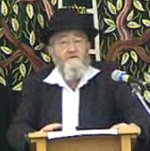Beit Midrash
- Torah Portion and Tanach
- Bamidbar
- Balak
The Torah study is dedicatedin the memory of
Simha Bat Hana
The Ramban takes a straightforward approach to the latter phrase. Bilam was describing his vantage point to look onto Bnei Yisrael, which, as the Torah mentions, was from the peaks overlooking the eastern side of the Jordan Valley. From there, he was able to see, says the Ramban, that they were indeed a group who was different from other bands of tribes. They were united by a single Torah, which gave them a unique, joint mission, as the pasuk’s famous ending can be understood.
Rashi apparently was not satisfied that Bilam’s location was noteworthy enough to highlight in this context and gives the phrase a historical, spiritual twist. He slightly inverts the phrase (not unusual in "poetic" passages), explaining that the mountaintops and hills are what Bilam saw, not his vantage point. Rashi explains that they refer to the patriarchs and matriarchs, who were like high places. He too connects the different parts of the p’sukim, saying that it was in the forebears’ merit that Bnei Yisrael were able to dwell in solitude.
One can ask whether, according to the Ramban, there is anything particularly significant about Bilam’s location. Again, the Ramban says that Bnei Yisrael were assembled in their encampment, unified around the Torah. If Bilam were to have seen them from lower, he would have seen only part of the nation. Seeing a unified segment would not have meant as much. It is not so difficult to get small groups to band together to strive for lofty ideals. The greatness that Bilam saw was an entire nation, made of twelve tribes, who reached that level.
The Ibn Ezra, whose commentary generally focuses on the Torah’s straightforward meaning, gives a fascinatingly novel explanation. The heights refer to decrees that slope down from the Heaven, as nations subjugate Bnei Yisrael. One might expect them to try to fit in with the nation that has dominion over them, but they remain a nation that dwells alone. Many of us know the insight in the "V’hi She’amda La’avoteinu" section of the Pesach Hagadda. It is based on the claim that the fact that nations afflict us is what helps us survive. Indeed, the Jewish nation does not "throw in the towel" when it reaches a painful chapter in our history. Rather, we redouble our resolve to stay together and rebuild as a nation. Of course, the most striking, recent example of this historical phenomenon is our determination, after the Holocaust, to establish our beloved Jewish State of Israel.
May Hashem give us the strength to persevere through hard times and swiftly bring us to the era of good times for the rest of history.

You Better Think
Rabbi Stewart Weiss | Taamuz 13 5781

A Prophet for the Nations
From Siach Shaul p. 425-6
Rabbi Shaul Yisraeli zt"l | Tamuz 7 5782

Bilam’s Arrogance
Hirsch At Your Table
Rabbi Matityahu Clark




















